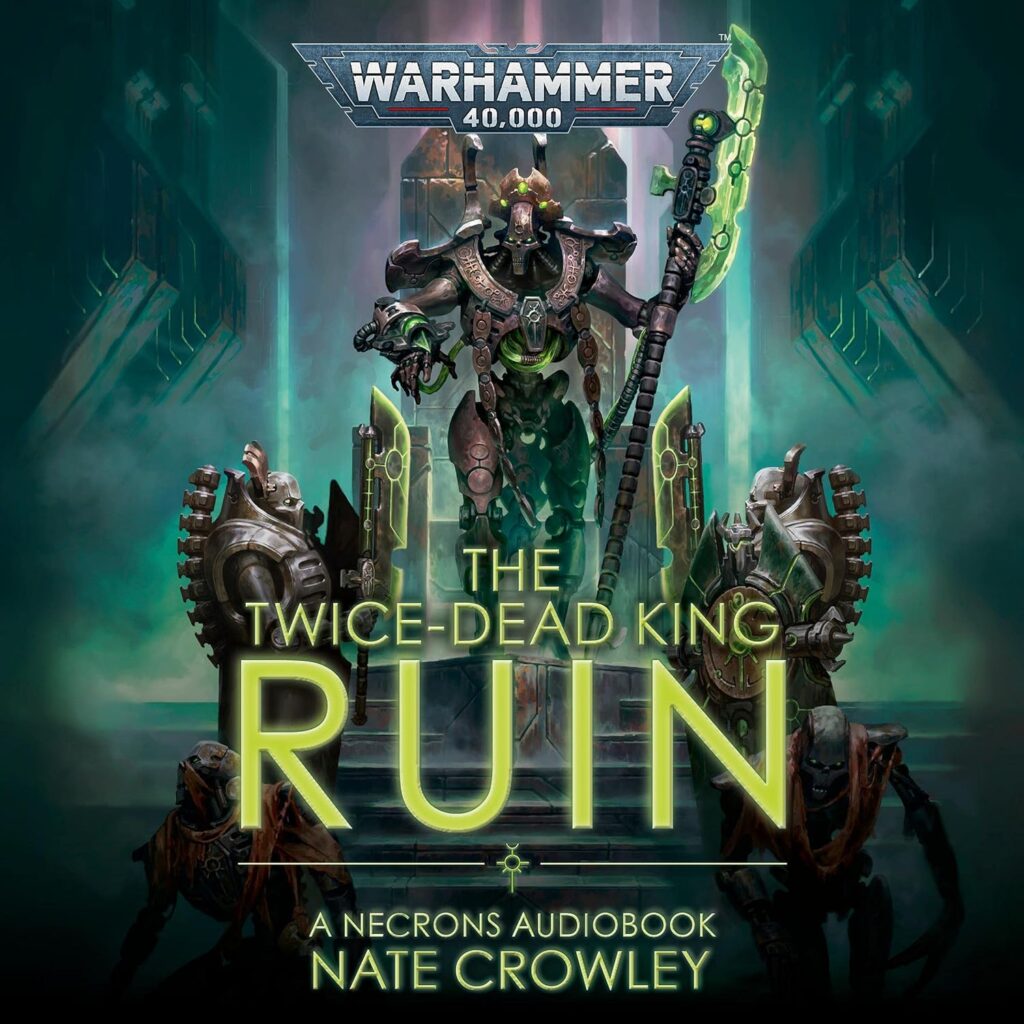Nate Crowley’s The Twice-Dead King: Ruin takes readers into the cold, calculating world of the Necrons, providing an in-depth exploration of this ancient, undead race as they contend with matters of loyalty, honor, and existential dread. With a blend of compelling characters, a unique perspective, and an intricately plotted storyline, Crowley’s novel adds nuance to the Warhammer 40K lore. We will examine the book’s plot, characters, and prose.
Plot:
The story follows Oltyx, a disgraced Necron noble exiled to a backwater tomb world after his fall from grace within the Mephrit Dynasty. Oltyx’s dishonor stems from his inability to navigate the rigid, dangerous political landscape of the Necron empire, a failing he continues to grapple with as he navigates his reduced circumstances. His sense of pride and bitterness is heightened by the threat of the Tyranids, who are encroaching upon his world with relentless aggression. As the novel unfolds, Oltyx faces numerous existential and personal challenges that force him to confront the values and loyalties he thought he held dear.
One of the most compelling aspects of the plot is how Crowley weaves Oltyx’s personal journey with the larger conflicts facing the Necron race. Oltyx’s story is not just about one Necron noble’s fight for redemption, but it also reflects the ancient struggles of his race against a galaxy filled with dangers. Crowley skillfully alternates between moments of personal introspection and sweeping, epic battles that capture the Necrons’ struggle to preserve their immortality and stave off both external and internal annihilation. The pacing of the plot is deliberate, balancing scenes of quiet introspection with intense action, which immerses readers in the heavy, ponderous atmosphere of Necron culture.
Characters:
Crowley crafts a complex and layered protagonist in Oltyx, whose sense of pride, failure, and ambition make him both relatable and tragic. Oltyx’s internal struggles are richly portrayed, exploring his deep-seated resentment and yearning for recognition, while his disdain for his exile, which he views as humiliating, drives his every action. This tension between pride and desperation is central to Oltyx’s character arc and makes him a compelling figure to follow.
The supporting characters are also vividly drawn, adding depth to the story. Oltyx’s rivals, whose ambitions and schemes complicate his life, serve as both adversaries and reflections of the ruthless Necron society. His lieutenants, meanwhile, represent various aspects of loyalty, duty, and ambition, each of them providing insights into how different Necrons view their existence and service. Each of these characters contributes to the story’s exploration of the Necron psyche and society, with Crowley highlighting their contrasting personalities while underscoring the Necrons’ shared sense of duty and pride.
One of the most interesting character dynamics is between Oltyx and the long-dead ghosts of his dynasty’s past, who occasionally appear as literal or metaphorical specters haunting his decisions. These specters serve as a reminder of both Oltyx’s shame and the weight of his family’s expectations, adding an extra layer of complexity to his journey.
Prose:
Crowley’s prose is dense and atmospheric, capturing the cold, detached tone one would expect from a Necron perspective. His writing style is deliberate, often evoking the timeless and mechanical existence of the Necron race. The descriptions are vivid and bring out the metallic, desolate aesthetic of Necron tomb worlds, with phrases that reflect both their ancient majesty and decaying grandeur. Crowley’s language is well-suited to the Necron mindset, using a formal and almost regal tone that fits the characters’ sense of honor and ancient pride.
The action sequences are intense and well-executed, emphasizing the mechanical precision and overwhelming firepower of the Necrons as they confront the Tyranid threat. Crowley uses a methodical approach to describe battles, which captures the implacable, unyielding nature of Necron warfare. His writing may feel a bit slow-paced to readers used to faster-paced Warhammer novels, but the contemplative tone works to enhance the novel’s themes of duty, legacy, and mortality.
Overall Summary and Verdict:
The Twice-Dead King: Ruin is a thoughtfully crafted and immersive exploration of the Necron race and its internal struggles, both personal and political. Crowley’s portrayal of Oltyx’s journey from disgraced noble to reluctant hero is compelling, and the character’s inner conflicts and motivations are given substantial depth. The novel’s plot balances grand, galactic stakes with intimate, character-driven moments, providing a unique perspective on the Necrons’ fight for survival and relevance in a hostile universe.
The prose style may feel slower than typical Warhammer 40K novels, but the reflective pace ultimately enhances the sense of time and weight of Necron culture. For readers interested in a story that delves deep into character motivations, interplays of loyalty, and existential themes, The Twice-Dead King: Ruin offers a rewarding experience. Crowley has delivered a nuanced and rich addition to Warhammer 40K that will resonate with fans of the lore and newcomers interested in exploring the Necron mindset.
And remember, Frontline Gaming sells gaming products at a discount, every day in their webcart!

